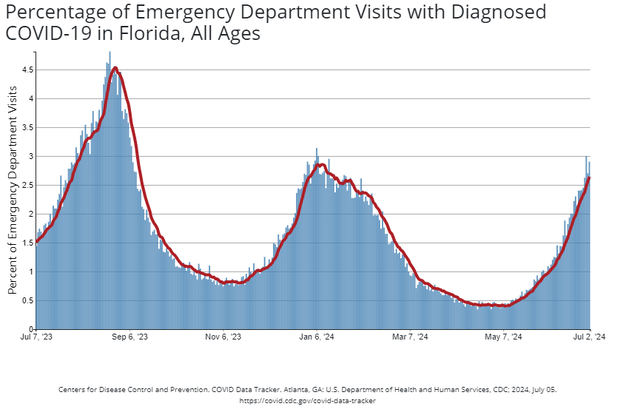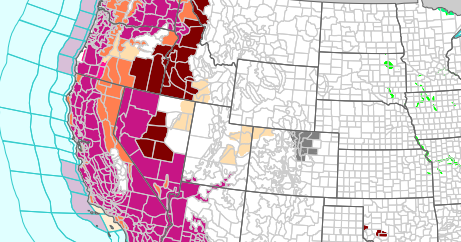Florida sees COVID-19 surge in emergency rooms, near last winter's peaks
Rates of COVID-19 have surged in Florida emergency rooms over recent weeks, according to new figures from the Centers for Disease Control and Prevention, and are now near peaks not seen since the worst days of this past winter's wave of the virus.
The weekly average of emergency room patients with COVID-19 has reached 2.64% in Florida, according to CDC data updated Friday, and now rank among the highest of any state during this summer's COVID-19 wave.
Trends from Florida have also climbed steeply in other key metrics that authorities now use to track COVID-19, including in wastewater and nursing homes.
Florida's steep increase in COVID-19 emergency room patients echoes that in some western states, which saw trends of the virus pick up in recent weeks.
Trends remain high across the West, though COVID-19 emergency room visits now appear to have peaked in Hawaii after recording some of the highest rates of patients in over a year.
"Over the past few weeks, some surveillance systems have shown small national increases in COVID-19; widespread as well as local surges are possible over the summer months," the CDC said in a bulletin issued Wednesday.
Nationwide, the majority of states are also now estimated to be seeing COVID-19 cases grow, the CDC's forecasters said this week.
A growing number of states have also begun to see COVID-19 increase in data from hospitals, the Centers for Disease Control and Prevention said Friday in its weekly report on the virus.
"Some areas of the country are experiencing consistent increases in COVID-19 activity, including increases in COVID-19 test positivity and emergency department visits and increases in rates of COVID-19–associated hospitalizations among adults 65+ at several sites," the agency said.
The agency has been cautious in recent weeks saying that this year's summer COVID-19 surge had arrived, saying that recent increases were coming off of record low levels of the virus.
"This past winter, COVID-19 peaked in early January, declined rapidly in February and March, and by May 2024 was lower than at any point since March 2020," the CDC said.
Outside of Florida and the West, rates of emergency room visits with the virus remain far from previous peaks, despite recent increases. Overall, the CDC says that nationwide activity of COVID-19 remains "low."
Previous years have seen COVID-19 activity pick up at least twice a year since the pandemic began, once during the summer or early fall after a lull during the spring, and then again during the winter, driven by new variants of the virus.
The closely related KP.2 and KP.3 variants are currently dominant nationwide, driving more than half of cases in recent weeks, according to estimates published Friday by the CDC.
Behind them, a mix of other variants have accelerated. LB.1 is next largest, at 14.9% of cases. And in the region spanning New Mexico through Louisiana, the CDC estimates a new variant called KP.4.1 surged to 17.9% of infections through June 22.




